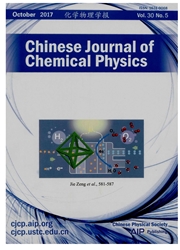

 中文摘要:
中文摘要:
在四点的甲醇和 methoxy 的吸附选择了地点(顶,桥牌, hcp, fcc ) 在 Cu (111 ) 上,表面被密度调查了在概括坡度近似(GGA ) 的功能的理论方法水平。干净 Cu (111 ) 表面上的 CH3OH 和 CH3O 的吸附精力,几何学和电子结构, Mulliken 费用,和震动的频率上的计算与完整几何学的优化被执行,并且与试验性的数据相比。获得的结果与可得到的试验性的数据一致。为 Cu (111 ) 表面上的甲醇的最喜爱的吸附地点是最高的地点,在公司轴被倾斜到表面的地方。而且,为 Cu (111 ) 表面上的 methoxy 的比较喜欢的吸附地点是 fcc 地点,和它与 pseudo-C3v 在正直的几何学吸附本地对称。可能的分解小径被寻找方法的转变状态也调查了。Methoxy 基, CH3O,被发现是分解中间。甲醇能在一个 Cu 原子上直接与它的氧原子在表面上被吸附,并且微弱地在 Cu (111 ) 表面上使用化学方法吸附。与甲醇相对照, methoxy 强烈被使用化学方法吸附到表面。
 英文摘要:
英文摘要:
Adsorption of methanol and methoxy at four selected sites (top, bridge, hcp, fcc) on Cu(111) surface has been investigated by density functional theory method at the generalized gradient approximation (GGA) level. The calculation on adsorption energies, geometry and electronic structures, Mulliken charges, and vibrational frequencies of CH3OH and CH3O on clean Cu(111) surface was performed with full-geometry optimization, and compared with the experimental data. The obtained results are in agreement with available experimental data. The most favorite adsorption site for methanol on Cu(111) surface is the top site, where C-O axis is tilted to the surface. Moreover, the preferred adsorption site for methoxy on Cu(111) surface is the fcc site, and it adsorbs in an upright geometry with pseudo-C2v local symmetry. Possible decomposition pathways also have been investigated by transition-state searching methods. Methoxy radical, CH3O, was found to be the decomposition intermediate. Methanol can be adsorbed on the surface with its oxygen atom directly on a Cu atom, and weakly chemisorbed on Cu(111) surface. In contrast to methanol, methoxy is strongly chemisorbed to the surface.
 同期刊论文项目
同期刊论文项目
 同项目期刊论文
同项目期刊论文
 Structural characterization and electronic properties of Ti-doped SnO2(110) surface: A first-princip
Structural characterization and electronic properties of Ti-doped SnO2(110) surface: A first-princip CO adsorption on MgO(001) surface with oxygen vancany and its low-coordinated surface sites: Embedde
CO adsorption on MgO(001) surface with oxygen vancany and its low-coordinated surface sites: Embedde Theoretical Study of N2O adsorption and decomposition at regular and defect sites of MgO(001) surfac
Theoretical Study of N2O adsorption and decomposition at regular and defect sites of MgO(001) surfac The adsorption and dissociation of Cl-2 on the MgO(001) surface with vacancies: Embedded cluster mod
The adsorption and dissociation of Cl-2 on the MgO(001) surface with vacancies: Embedded cluster mod Organic Functionalization of Diamond (100) by Addition Reactions of Carbene, Silylene, and Germylene
Organic Functionalization of Diamond (100) by Addition Reactions of Carbene, Silylene, and Germylene Investigating the role of cationic vacancy on the MgO (001) defect surface: Embedded cluster model s
Investigating the role of cationic vacancy on the MgO (001) defect surface: Embedded cluster model s 期刊信息
期刊信息
